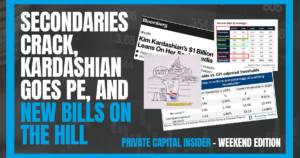you count yourself among those who believe gold will continue its upward climb from here, the question you should be asking is…
“What’s the best way to play the trend?”
For those looking to make a small (but speculative) bet on gold prices going higher, you might consider buying gold futures, options contracts, or junior mining stocks, but each has its risks.
Futures and options can be complicated and extremely risky for investors who do not have a deep understanding of the derivatives markets.
While mining stocks may appear to be surging, they tend to be far more volatile than most investors can stomach.
That’s what we’ll be talking about in today’s issue of Private Capital Insider.
Let’s dive in,
-Jake Hoffberg
P.S. Equifund just launched its latest Regulation A+ offering for an already-publicly-traded gold royalty and streaming company.
As a reminder, securities sold under Reg CF, Reg A, Reg A+, and Reg D are often considered high risk, and speculative in nature. Please do not invest funds you cannot afford to lose, or otherwise need immediate access to the invested capital.
The Big Idea
A new way to capture the
upside potential of junior gold miners
For investors looking to capture potential gains from the gold markets, junior mining companies arguably provide the highest potential rewards.
However, they also come with extraordinary operational risk. Not only do they have to bear the upfront cost of finding a workable mineral asset, they have to extract those minerals before they can generate revenue (let alone profit).

Because of this risk profile – along with a general dislike for mining companies in capital markets – there are limited financing opportunities for junior mining companies.
The end result? Junior miners can find themselves stuck between the proverbial “rock and a hard place” – they need money to develop the property, but they can’t get access to capital until the property is further developed.
“A typical junior mining company will find an asset that has promise… raise capital to explore the property… and then raise more money to develop it.
To secure financing, they have to go to a very small number of brokers who will fund these types of deals. However, these brokers are not long term investors; their business model is to dump their shares as soon as they can, which inevitably causes the share price to crater from the selling activity.
These financiers are the biggest problem in these deals and are the primary reason why mine operators – and retail investors – tend to have far greater risks, both short term and long term.”
But what if there was a way to decrease one of the most controllable forms of risk…
The mining company is unable to execute on their business plan, because they run out of capital – and are potentially unable to secure additional capital – due to predatory financing arrangements.
That’s exactly why alternative financing agreements – like Golden Cash Flow Contracts – provide a “win-win” solution for junior mining companies and investors.
In exchange for a non-dilutive source of capital today, the mining company agrees to give investors a long-term, annuity-like repayment with two forms of downside protection… and a small chance for significant potential upside.
Here’s how it works…
As long as the mine is producing, investors are entitled to a portion of either the revenue generated by the company (a royalty)… or the actual metal production at a discounted price (a stream).
Generally speaking, royalties are created when a junior explorer needs money to continue exploring his land package. Streams are created when a mine developer needs to raise capital to build a mine. (Img: Visual Capitalist)
This means…
- It doesn’t matter if the mine is profitable or not.
As long as gold is being mined, investors who own Golden Cash Flow Contracts still get paid.
- It doesn’t matter if the mining company runs out of money and crushes equity and debt holders.
Golden Cash Flow Contracts cannot be discharged in bankruptcy. They’re attached to the property until all contractual conditions are met.
This also means that if the property is ever sold to another mining company, and brought into production… The Golden Cash Flow Contract stays attached and investors still get paid.
In fact…
- It doesn’t matter if any gold is ever produced from the property. Investors can still potentially get paid!
Why? It all has to do with the way Golden Cash Flow Contracts are structured. Unlike an options contract that gives holders the right to purchase an asset at a specified price, for a specified duration of time, but can also expire worthless…
Golden Cash Flow Contracts are valued relative to the property’s reserve and resource reports, as well as its potential future cash flows.
This means that aside from instances of fraud – or the price of gold dropping so low that the property is unprofitable to mine (known as “impairment”) – the Golden Cash Flow Contracts will likely retain value.
To be clear, all investments carry some sort of risk. Golden Cash Flow Contracts are not a sure thing, and there is potential for the loss of some or all of the principal invested.
However, this financing strategy creates a compelling value proposition for shareholders in the current macroeconomic environment: downside protection, cash flows, and significant potential upside.
Gameboard
A business model that produces more revenue per employee than Amazon, Facebook, Apple, and Alphabet… combined!
In 2019, Royal Gold – one of the world’s leading precious metals stream and royalty companies – generated over $499 million in revenue, and with just 29 employees: an unbelievable $17 million in revenue per employee.
In 2019, Royal Gold generated an unbelievable $17 million in revenue per employee – many times more what some of the world’s largest mining and tech firms generated on a per-employee basis.
The world’s biggest R&S company, Franco-Nevada, had only 40 employees at the end of 2021, while its revenue was nearly $1.3bn. This amounts to $32.4m per employee.
For comparison, the world’s biggest gold miner, Newmont Corporation, had 14,400 employees and revenues of $12.2bn, or roughly $850,000 per employee.

It’s a beautiful low-cost setup that – coupled with a diverse portfolio of revenue generating assets – is a large part of the reason why the R&S business model may be so successful… even when their underlying commodities have underperformed.
This means it is significantly easier to scale versus the high cost of building a gold mine.
Playbook
The Power of Embedded Optionality
For investors, R&S companies provide commodity-price leverage – known as “Embedded Optionality” – and exposure to the underlying commodities and price movements.
This means if gold prices go up, the potential value of the R&S contracts also increases.
Seeking Alpha
Not only would each ounce of gold produced be worth more, it could potentially bring reserves into play that weren’t profitable to mine at lower gold prices… further increasing the value of the R&S contract.
“[Golden Cash Flow Contracts] are fantastic financial instruments because of that embedded optionality, commodity optionality, price optionality… but more important is discovery optionality.
Other types of optionality people don’t think about is the establishment of more infrastructure, cheaper electricity, advancement of metallurgical technologies, engineering technologies.
All of which are to the benefit of the [investor] because it increases the resources in the ground, increases the reserve, increases production over time, at no cost to the royalty holder.
It’s those aspects of embedded optionality – like on the Carlin Trend and some of the first [Golden Cash Flow Contracts] Franco Nevada acquired – would be preeminent examples of those optionalities all coming in to help them multiply and win in a huge way.”
If the price of gold goes up, every ounce of gold mined is worth more, and the value of the Golden Cash Flow Contracts go up.
And if the higher gold prices – combined with new mining technologies – can bring reserves into play that weren’t profitable to mine at lower gold prices… the value of the Golden Cash Flow Contracts go up.
That’s exactly what happened in 1985 when Lassonde made the first ever Golden Cash Flow Contract.
Lassonde made a $2m bet – roughly half of the cash in treasury – to acquire a 4% royalty on the Goldstrike mine (which is still in production today).
Today, that single investment has produced $800 million in revenue and is expected to make $1.2 billion in total profits… an astronomical 59,990% return.
This single Golden Cash Flow Contract served as the foundation for one of the best performing “gold stocks” in history; Franco-Nevada delivered a 15,614% return over 18 years for their shareholders… while gold returned essentially 0% over the same time frame.
“old” Franco Nevada’s incredible rise from CAD$0.21 per share and a market capitalization of CAD$2 million, to the eventual buy out by Newmont for CAD$2.5 billion at over CAD$33 per share – a 15,614% return in 18 years!
“We grew the company at 36 percent compounded for 19 years in a row.
Even Warren Buffet doesn’t have a record of 36 percent per year compounded.”
“We get a free perpetual option on the discoveries made on the land by the operators, and we get a free perpetual option on the price of gold.
It’s the optionality value of the land, the value of the operator spending money on our land, and the optionality to higher gold prices. And that is worth so much money.
When you buy a stream, on the other hand, you get price optionality. You’re buying, say, 100,000 ounces of gold for the next 25 years. So you get optionality on the price of the commodity, but you don’t get much optionality on the land.”
Put another way; They were able to secure a Golden Cash Flow Contract on promising properties… got “lucky” on the embedded optionality portion of the play… and leveraged that success into more success.
“While the growth in private debt and equity has been below expectations, one form of alternative financing that has blossomed has been [Golden Cash Flow Contracts].
Expansion in this form of alternative financing, coupled with increasing focus on growth by management teams, leads us to believe that [Golden Cash Flow Contracts are] poised for strong growth over the next decade.”
Which might lead you to ask the obvious question…
If this is such a good strategy, why isn’t everyone doing this?
A smarter way to speculate on rising gold prices
Today, the top three buyers — Wheaton Precious Metals, Franco-Nevada Corporation, and Royal Gold — represent approximately 80% of the total value of streaming-and-royalty contracts as defined by volume of gold equivalent ounces (GEOs).

However, the majors are mostly interested in acquiring R&S contracts on larger producing mines. And these assets are in high demand, and are difficult to acquire at favorable terms.
“In the early days, royalties were created by prospects who would sell their properties and keep a cut off the top of production in the future.
That has evolved where the big royalty companies have become financing institutions. They are providing financing via royalties and streams – which are similar financial instruments – to finance the advancement of production.
Mr. Cole also admits that buying Golden Cash Flow Contracts is a tough business. Plenty of investors are aware of the many benefits they carry, and as a result, the “blue chip” contracts on large producing mines trade at premiums.
However, there is little to no competition for royalty and streaming contracts on smaller assets in the pre-production stage.
At first glance, targeting smaller and earlier stage properties carries substantially higher risk.
However, for investors looking to generate outsized returns…
The key is to be both “contrarian and right” – which in practical terms, means looking for speculative investment opportunities that have misunderstood – and therefore, mispriced – risk factors.

Some of today’s most successful R&S companies started out with a very low stock price/market cap but were able to successfully (and quickly) scale the business.
According to an investor presentation by Ely Gold Royalties:
- Sandstorm Gold (SAND) stock increased nearly 700% between 2009 to 2013.
- Franco-Nevada (FNV) went up 2,700% in years 1-4
- Royal Gold (RGLD) shot up 3,200% in years 1-4
- Abitbi Royalties (acquired by Gold Royalty) saw a 3,625% increase in years 1-5

While there is of course no guarantee that simply “getting in early” on a new gold royalty and streaming company will generate these types of returns (or any positive returns for that matter)…















